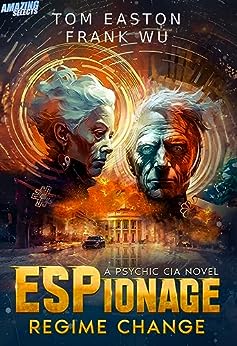(1) TICKET AGENCY OFFERS CHENGDU WORLDCON ADMISSIONS. [Item by Ersatz Culture.] The SF Light Year Weibo account posted on August 11 that Chengdu Worldcon tickets would be put up for sale on a Ticketmaster-style service. [Screencap of computer-translated post.]

Damai listing page which has much the same info. [Screencap of computer-translated post.]

Here’s a 2017 text story in Google’s cache confirming that Damai is a Ticketmaster equivalent: “Alibaba acquires China’s biggest ticket seller Damai”.
In itself, I don’t think this story is particularly controversial or bad, but just another indicator that this is a Worldcon like no other before…
(2) SOMETHING BORROWED. WorldCat identifies the “Top 25 books requested via interlibrary loan January through June 2023”. There are at least three sff books including R.F. Kuang’s Babel.
Here are the 25 books most frequently requested for interlibrary loan from January through June 2023 through the OCLC resource sharing network of 10,000+ libraries worldwide.
(3) SUPERMEN BEFORE SUPERMAN. Bleeding Cool remembers when “George Bernard Shaw Sent Lawyers After DC Comics About Superman”. The post is based on the “Superman 1939 Jerry Siegel Internal Memo Memorabilia” up for auction at ComicConnect.
…But back in 1938, there were other accusations in play. Readers have noted that Superman bore some resemblance to the lead character of Philip Wylie‘s Gladiator novel from 1930. Less than a year after Superman debuted in Action Comics #1, National Comics executive Jack Liebowitz was sending this letter to Siegel that suggests that Wylie had actually acted upon his threats of a lawsuit. And that the same attorney was also representing George Bernard Shaw, author of the play Man and Superman, suggesting George Bernard Shaw he was also being represented in legal negotiations with National Comics….
(4) ROUND TWO. {Item by Mike Kennedy.] Here’s a companion piece for the ongoing Internet Archive book copyright issue. “Record Labels File $412 Million Copyright Infringement Lawsuit Against Internet Archive” at Rolling Stone.
Complaint claims organization’s “Great 78 Project,” which includes music from Frank Sinatra, Ella Fitzgerald, and more serves as an “illegal record store”
Universal Music Group, Sony Music Entertainment, Capitol, and other record labels filed a copyright lawsuit on Friday against Internet Archive, founder Brewster Kahle, and others over the organization’s “Great 78 Project,” accusing them of behaving as an “illegal record store.” The suit lists 2,749 pre-1972 musical works available via Internet Archive by late artists, including Frank Sinatra, Ella Fitzgerald, Chuck Berry, Billie Holiday, Louis Armstrong, and Bing Crosby, among others.
The suit, which was filed in federal court and reviewed by Rolling Stone, claims the Internet Archive’s “Great 78 Project” — launched by Internet Archive as a community project for “the preservation, research and discovery of 78rpm records,” according to its blog — has violated copyright laws. By “transferring copies of those files to members of the public, Internet Archive has reproduced and distributed without authorization Plaintiffs’ protected sound recordings,” the suit alleges.
The Internet Archive blog’s explanation of the The Great 78 Project says in part:
…We aim to bring to light the decisions by music collectors over the decades and a digital reference collection of underrepresented artists and genres. The digitization will make this less commonly available music accessible to researchers in a format where it can be manipulated and studied without harming the physical artifacts. We have preserved the often very prominent surface noise and imperfections and included files generated by different sizes and shapes of stylus to facilitate different kinds of analysis.
78s were mostly made from shellac, i.e., beetle resin, and were the brittle predecessors to the LP (microgroove) era. The format is obsolete, and just picking them up can cause them to break apart in your hands. There’s no way to predict if the digital versions of these 78s will outlast the physical items, so we are preserving both to ensure the survival of these cultural materials for future generations to study and enjoy…
(5) REASONS TO LISTEN. [Item by Steven French.] Interesting review of a BBC Proms – Prom 36: A Space Odyssey, a concert available on BBC Sounds until October 9th:
The Guardian’s Tim Ashley says: “Prom 36 A Space Odyssey: LPO/Gardner review – unsettling and awesome”.
Strauss’s Zarathustra, meanwhile, was rich in drama and detail, the playing finely focused and sensually immediate. We can easily forget that, like 2001, it deals with human evolution. But it also has points in common with Ligeti’s Requiem, notably its comparably ambivalent ending, oscillating between keys to an irresolute silence and asking more questions than it can ever answer. Ligeti was apparently uncertain about their juxtaposition. Kubrick, you realise, knew exactly what he was doing in putting them together.
(6) A TELE-ALL BOOK. Tom Easton and Frank Wu have a new book coming out – ESPionage: Regime Change — Frank’s first novel, Tom’s 13th. It’s about psychics in the CIA battling Russians trying to assassinate the US President. Pre-order the ebook on Amazon.com, or order the paperback edition when it’s available on August 28.

There’s mind-reading, telekinesis, and telepyrosis! Love and romance! Guns & explosions! A gun hidden in a camera! A fighting style based on 70’s rock! A bad iPhone game that’s really spy software! Secret messages sent in a Paul Simon song! Excitement and action action action!
Amazing Stories did a Q&A with Frank in honor of the occasion: “Unexpected Questions with Frank Wu”. It includes a whole alternate history scenario built around the career of astronaut John Glenn.
(7) TODAY’S BIRTHDAYS.
[Compiled by Cat Eldridge.]
- Born August 13, 1895 — Bert Lahr. Best remembered and certainly beloved as The Cowardly Lion in The Wizard of Oz, as well as his counterpart who was a Kansas farmworker. It’s his only genre role, though in the film Meet the People, he would say “Heavens to Murgatroyd!” which was later popularized by a cartoon character named Snagglepuss. (Died 1967.)
- Born August 13, 1899 — Alfred Hitchcock. If he’d only done his two Alfred Hitchcock series which for the most part was awesome, that’d be enough to get him Birthday Honors. But he did some fifty films of which a number are genre such as The Birds and Psycho. Though I’ve not yet read it, I’ve heard good things about Peter Ackroyd’s Alfred Hitchcock: A Brief Life. (Died 1980.)
- Born August 13, 1909 — Tristram Coffin. He’s best remembered for being Jeff King in King of the Rocket Men, a Forties SF serial, the first of three serials featuring this character. He showed up on the Fifties Superman series in different roles, sometimes on the side of Good, sometimes not. He played The Ambassador twice on Batman in “When the Rat’s Away the Mice Will Play” and “A Riddle a Day Keeps the Riddler Away”. (Died 1990.)
- Born August 13, 1922 — Willard Sage. He showed up on Trek as Thann, one of the Vians in “The Empath”. He was Dr. Blake in Colossus: The Forbin Project, and had roles in The Land of Giants, Invaders, The Man from U.N.C.L.E., The Outer Limits and The Sixth Sense. (Died 1974.)
- Born August 13, 1932 — John Berkey. Artist whose best-known work includes much of the original poster art for the Star Wars trilogy. He also did a lot of genre cover art such as the 1974 Ballantine Books cover of Herbert’s Under Pressure (I read that edition), and the 1981 Ace cover of Zelazny’s Madwand which I think is the edition I read. (Died 2008.)
- Born August 13, 1965 — Michael De Luca, 58. Producer, second Suicide Squad film, Childhood’s End, Ghost Rider and Ghost Rider: Spirit of Vengeance, Dracula Untold, Lost in Space, Blade and Blade II, Pleasantville and Zathura: A Space Adventure which is not a complete listing. Also writer for an episode of Star Trek: Voyager, the first Dredd film (oh well), the Freddy’s Nightmares series and the Dark Justice series which though not quite genre was rather fun. Anyone remember the latter? I liked it a lot.
- Born August 13, 1977 — Damian O’Hare, 46. Though you might know him from the Pirates of the Caribbean films, The Curse of the Black Pearl and On Stranger Tides where he played Gillette, I know him as the voice of John Constantine on the animated Justice League Action. He also showed up in Agent Carter.
- Born August 13, 1990 — Sara Serraiocco, 33. She plays the complex role of Baldwin on the Counterpart series which I finally got around to watching and it’s absolutely fascinating. I will also admit it’s nice to see a SF series that’s truly adult in nature with realistic violence.
(8) COMICS SECTION.
- The Argyle Sweater has pretty much the darkest take on Winnie-the-Pooh ever.
(9) SUGGESTED PROTECTIVE CONTRACT LANGUAGE. [Item by Danny Sichel.] Deborah Beale — who, in addition to being married to Tad Williams, has a substantial background in the business side of genre publishing — posted a useful boilerplate statement for authors concerned about large language models based on something in one of Mercedes Lackey’s contracts.
(10) MAKE A CRITICAL ROLE. [Item by Mike Kennedy.] Herein is the tale of how one man turned being a D&D Game Master into a full time job and a multi-million dollar business. “The Game Master” at Slate.
…Today he is, without question, the most famous Dungeons & Dragons player in the world. Every Thursday, he and a group of friends gather in a studio for the latest episode of Critical Role—a show, broadcast on the livestreaming platform Twitch, which doubles as Mercer’s weekly tabletop RPG campaign. The structure should be familiar to anyone who’s palmed a 20-sided die in their youth: Mercer, as Game Master, is the primary storyteller. He provides the narrative elements, motifs, and obstacles for his players, who reciprocate by embodying a band of high-fantasy ne’er-do-wells who explore the world he’s created. (There’s been Pike the gnomish cleric, Vex the half-elf ranger, and Grog the Goliath barbarian to name a few.) Together—seated around a set made to look like the torchlit halls of a stone-wrought castle—they roll dice, slay monsters, and dream up their very own Lord of the Rings–sized epic. In one episode, the crew descends into a labyrinthine sewer system to fight off a massive spider. In another, they infiltrate a royal ball that exists between dimensions. Dungeons & Dragons is essentially an exercise in collaborative storytelling, which means Critical Role is unedited and unscripted—those who tune in watch the saga unfold in real time.
This was a radical premise when the show launched in 2015. Dungeons & Dragons was not considered to be spectator entertainment—much less an entrepreneurial enterprise—at any point throughout its previous 40-year history. Nobody, least of all Mercer, expected Critical Role to be a hit….
(11) I CAN SEE CLEARLY NOW. “How The Witcher Will Explain Geralt Changing from Henry Cavill to Liam Hemsworth Seems Clear Now” according to Redanian Intelligence. Their theory is at the link.
The Witcher Season 4 will replace its titular character, Geralt of Rivia. Henry Cavill will no longer don the ash-white wig, the suit of armor, and the twin swords. The Hunger Games star Liam Hemsworth will step into Cavill’s very large shoes and become the new Geralt starting with Season 4. Though we reported not long ago that filming of Season 4 has been delayed to 2024 due to the WGA and SAG-AFTRA strikes, Netflix is still very much determined to produce this next season of the show. One of the few officially confirmed plot points of this fourth season involves Geralt of Rivia’s new face….
(12) AI UP TO BAT. [Item by Steven French.] “’Only AI made it possible’: scientists hail breakthrough in tracking British wildlife” reports the Guardian. If they help us spot more pipistrelle bats, then I for one welcome our AI overlords!
…“Bats almost certainly use railway bridges for roosting,” Dancer told the Observer. “So if we can get more detailed information about the exact locations of their roosts using AI monitors, we can help protect them.”
This point was underlined by Strong. “In the past, we have had to estimate local wildlife populations from the dead animals – such as badgers – that have been left by the track or the roadside. This way we get a much better idea of population sizes.”…
[Thanks to John King Tarpinian, Chris Barkley, Michael Toman, Ersatz Culture, Rich Horton, Danny Sichel, Cat Eldridge, SF Concatenation’s Jonathan Cowie, Mike Kennedy, and Andrew Porter for some of these stories. Title credit belongs to File 770 contributing editor of the day Andrew (not Werdna).]

